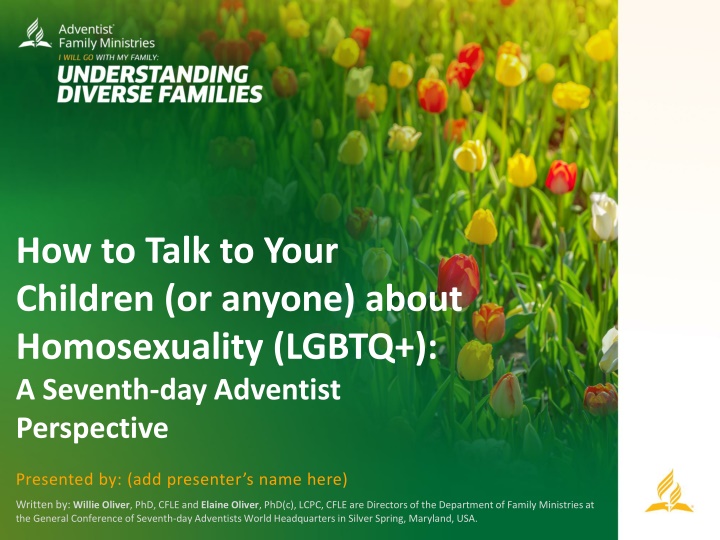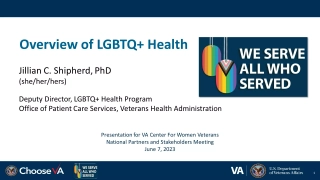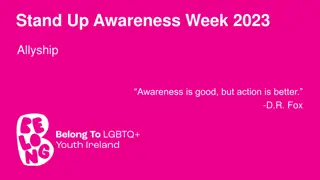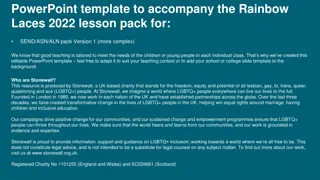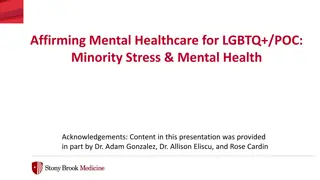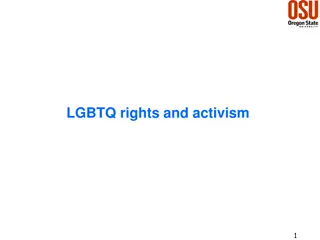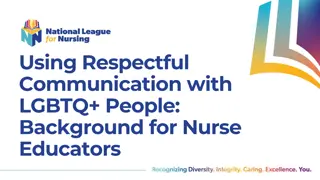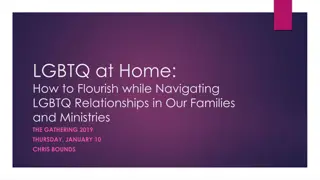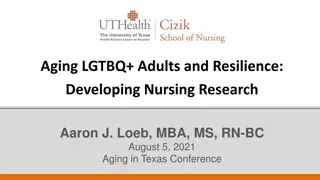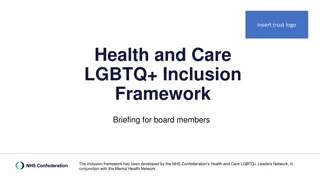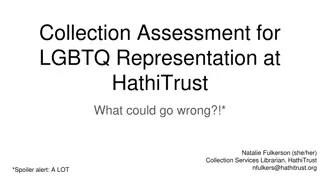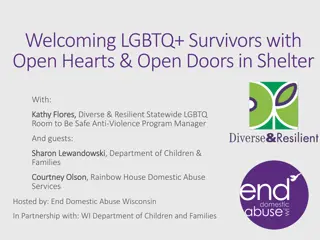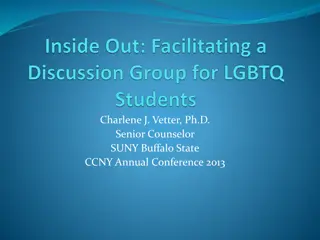Talking to Children About LGBTQ+ Trends
In a changing world, understanding LGBTQ+ trends is essential for meaningful conversations with children. Explore insights from Seventh-day Adventist perspectives on sexuality and identity, addressing the need for intentional dialogues from early ages.
Download Presentation

Please find below an Image/Link to download the presentation.
The content on the website is provided AS IS for your information and personal use only. It may not be sold, licensed, or shared on other websites without obtaining consent from the author.If you encounter any issues during the download, it is possible that the publisher has removed the file from their server.
You are allowed to download the files provided on this website for personal or commercial use, subject to the condition that they are used lawfully. All files are the property of their respective owners.
The content on the website is provided AS IS for your information and personal use only. It may not be sold, licensed, or shared on other websites without obtaining consent from the author.
E N D
Presentation Transcript
How to Talk to Your Children (or anyone) about Homosexuality (LGBTQ+): A Seventh-day Adventist Perspective Presented by: (add presenter s name here) Written by: Willie Oliver, PhD, CFLE and Elaine Oliver, PhD(c), LCPC, CFLE are Directors of the Department of Family Ministries at the General Conference of Seventh-day Adventists World Headquarters in Silver Spring, Maryland, USA.
BIBLE TEXTS: But now, thus says the Lord, who created you, O Jacob, and He who formed you, O Israel: Fear not, for I have redeemed you; I have called you by your name; You are Mine. Isaiah 43:1 Before I formed you in the womb I knew you; before you were born, I sanctified you; I ordained you a prophet to the nations. Jeremiah 1:5 I will praise you, for I am fearfully and HOW TO TALK TO YOUR CHILDREN (OR ANYONE) ABOUT HOMOSEXUALITY (LGBTQ+): A SEVENTH-DAY ADVENTIST PERSPECTIVE wonderfully made. Marvelous are Your works; and that my soul
BEHIND THE ACRONYM: Behind the acronym are people that we know and love. The percentage of U.S. adults who identify as something other than heterosexual has doubled from 3.5 percent in 2012 to 7.1 percent in 2022. This increase is primarily due mostly to the high LGBTQ self-identification, particularly as bisexual, among the Generation Z adults who are ages 18-25. For GenZ, more than 1 in 5, or 21 percent identify as LGBTQ. Globally, on average, 80 percent identify as heterosexual and 20 percent identify as gay, lesbian, bisexual, transgender, asexual, or other. https://news.gallup.com/poll/329708/lgbt-identification-rises-latest-estimate.aspx HOW TO TALK TO YOUR CHILDREN (OR ANYONE) ABOUT HOMOSEXUALITY (LGBTQ+): A SEVENTH-DAY ADVENTIST PERSPECTIVE https://www.ipsos.com/en/ipsos-lgbt-pride-2021-global-survey
Undeniably, we are living in a time of what is known as sexual fluidity or non-binary expression of gender. Fluidity means that gender can or does change over time, and non-binary means that some people believe they may not fit neatly into the category or being either male or female. As these sexual trends shift globally, so too will trends shift in the church. Thus, we are likely to see more young people in our families, schools, and churches questioning their sexuality, their identity, and the biblical sexual ethic they ve been taught or sadly never taught. While it is said that values are caught not taught, sexuality is a topic that requires intentional conversations, and these should begin from birth. HOW TO TALK TO YOUR CHILDREN (OR ANYONE) ABOUT HOMOSEXUALITY (LGBTQ+): A SEVENTH-DAY ADVENTIST PERSPECTIVE
With these veritable truisms, what remains at the heart of these trends and the LGBTQ conversation are people real people with real feelings, attractions, and a yearning to love and be loved. Most people reading or listening to this seminar know someone who identifies as LGBTQ, a friend, neighbor, co-worker, distant relative, parent or child. So, to begin to understand LGBTQ, we must first stop saying those people and making a distinction between them and us. We ALL long for belonging, a yearning to be loved, and a deep desire for intimacy. ALL humankind wants to be treated with respect and dignity. If we keep this is mind, the rest of this seminar will be easier to HOW TO TALK TO YOUR CHILDREN (OR ANYONE) ABOUT HOMOSEXUALITY (LGBTQ+): A SEVENTH-DAY ADVENTIST PERSPECTIVE comprehend.
As a community of faith and disciples of Jesus Christ, we have no choice but to love like Jesus and spread the good news of the gospel to everyone. The same God who promised Israel freedom from bondage, despite their rebellious nature and infidelity, still intends to keep His promises of a hopeful future and restored identity to us today. But now, thus says the Lord, who created you, O Jacob, and He who formed you, O Israel: Fear not, for I have redeemed you; I have called you by your name; HOW TO TALK TO YOUR CHILDREN (OR ANYONE) ABOUT HOMOSEXUALITY (LGBTQ+): A SEVENTH-DAY ADVENTIST PERSPECTIVE You are Mine. Isaiah 43:1
We are the conduits through which all people may find freedom and a new identity in Christ, including those who identify as LGBTQ. All have sinned and are inadequate to receive God s grace, but His love is steadfast, and He provides new mercies every morning. Romans 3:23, Lamentations 3:22 HOW TO TALK TO YOUR CHILDREN (OR ANYONE) ABOUT HOMOSEXUALITY (LGBTQ+): A SEVENTH-DAY ADVENTIST PERSPECTIVE
Dignity and Compassion for all: Understanding the Seventh-day Adventist Position on Homosexuality It is essential to know what the church s statements say and how we can share our position in a positive and winsome manner. Equally as important is knowing that it is from the word of God, and the heart of it is love for God's people. SDA Statements and guidelines are developed with much prayer, thought, study of God's word, and study of various disciplines on the intended topic by the theologians from the SDA Biblical Research Institute and, depending on the topic, may include SDA physicians, sociologists, psychologists, ethicists, and other relevant professionals. HOW TO TALK TO YOUR CHILDREN (OR ANYONE) ABOUT HOMOSEXUALITY (LGBTQ+): A SEVENTH-DAY ADVENTIST PERSPECTIVE
Dignity and Compassion for all: Understanding the Seventh-day Adventist Position on Homosexuality cont. These statements and guidelines are not based solely on one person's opinions with a group of supporters who endorse that person's opinion or scholars from other denominations or the latest evidence-based findings. Personal biases are put to the side as much as is humanly possible, and there is a deep search for divine guidance from the Bible. These statements and guidelines reflect a biblical worldview and not a contemporary popular secular worldview. As people of faith, we should always seek to, first and foremost, use a biblical worldview as our framework for understanding even contemporary issues. HOW TO TALK TO YOUR CHILDREN (OR ANYONE) ABOUT HOMOSEXUALITY (LGBTQ+): A SEVENTH-DAY ADVENTIST PERSPECTIVE The Bible is relevant for all ages.
HOW TO TALK TO YOUR CHILDREN (OR ANYONE) ABOUT HOMOSEXUALITY: A SEVENTH-DAY ADVENTIST PERSPECTIVE GROUP EXERCISE
GROUP EXERCISE Seventh-day Adventist Position Statement on Homosexuality The Seventh-day Adventist Church recognizes that every human being is valuable in the sight of God, and we seek to minister to all men and women in the spirit of Jesus. We also believe that by God s grace and through the encouragement of the community of faith, an individual may live in harmony with the principles of God s Word. Seventh-day Adventists believe that sexual intimacy belongs only within the marital relationship of a man and a woman. This was the design established by God at creation. The Scriptures declare: For this reason a man will leave his father and mother and be united to his wife, and they will become one flesh (Gen 2:24, NIV). Throughout Scripture this heterosexual pattern is affirmed. The Bible makes no accommodation for homosexual activity or relationships. Sexual acts outside the circle of a heterosexual marriage are forbidden (Lev 18:5- HOW TO TALK TO YOUR CHILDREN (OR ANYONE) ABOUT HOMOSEXUALITY (LGBTQ+): A SEVENTH-DAY ADVENTIST PERSPECTIVE 23, 26; Lev 20:7-21; Rom 1:24-27; 1 Cor 6:9-11).
GROUP EXERCISE Seventh-day Adventist Position Statement on Homosexuality cont. Jesus Christ reaffirmed the divine creation intent: Haven t you read, he replied, that at the beginning the Creator made them male and female, and said, For this reason a man will leave his father and mother and be united to his wife, and the two will become one flesh? So they are no longer two, but one (Matt 19:4-6, NIV). For these reasons Seventh-day Adventists are opposed to homosexual practices and relationships. Jesus affirmed the dignity of all human beings and reached out compassionately to persons and families suffering the consequences of sin. He offered caring ministry and words of solace to struggling people, while differentiating His love for sinners from His clear teaching about sinful practices. As His disciples, Seventh-day Adventists endeavor to follow the Lord s instruction and example, living a life of Christ-like compassion and faithfulness. This statement was voted during the Annual Council of the General Conference Executive Committee on Sunday, October HOW TO TALK TO YOUR CHILDREN (OR ANYONE) ABOUT HOMOSEXUALITY (LGBTQ+): A SEVENTH-DAY ADVENTIST PERSPECTIVE 3, 1999 in Silver Spring, Maryland. Revised by the General Conference Executive Committee, October 17, 2012.
Here are other statements pertaining to marriage and sexuality: https://family.adventist.org/resources/real-answers/statement-of-concern-on- sexual-behavior/ https://family.adventist.org/people/couples/an-affirmation-of-gods-gift-of- sexuality/ https://family.adventist.org/resources/real-answers/seventh-day-adventist- response-to-same-sex-unions-a-reaffirmation-of-christian-marriage/ https://www.adventist.org/official-statements/statement-on- transgenderism/?searchsite=www.adventist.org&ref=on-site- search&searchterm=statement+on+transgender HOW TO TALK TO YOUR CHILDREN (OR ANYONE) ABOUT HOMOSEXUALITY (LGBTQ+): A SEVENTH-DAY ADVENTIST PERSPECTIVE
Understanding LGBTQ Throughout the years, various words have taken on a different meanings and new terminology has emerged especially regarding LGBTQ people. Here we will share a list of key terms that are essential to understanding the current dialogue. It is by no means an exhaustive list, but it will help you begin to understand and engage in the conversation. Sexual Identity: Term a person uses to describe their sexuality or sexual orientation. Homosexual: A person who is attracted to the same sex/gender. In society at large, this word is now considered derogatory and offensive, the word queer is the preferred term. While the word homosexuality is used in the Scripture, when referencing LGBTQ people, it is best to use language that people use to define themselves. If it does not compromise your core beliefs and values, even if you are uncomfortable with it, you can honor the request. To be sure, it is always safe to say LGBTQ, if you HOW TO TALK TO YOUR CHILDREN (OR ANYONE) ABOUT HOMOSEXUALITY (LGBTQ+): A SEVENTH-DAY ADVENTIST PERSPECTIVE prefer not to use queer.
Understanding LGBTQ Straight/Heterosexual: A person who is attracted exclusively to the opposite sex/gender. Queer: An umbrella term referring to LGBTQ people. In the past it was considered a derogatory term but has recently been reclaimed as an empowering identifier. It is used interchangeably with LGBTQ. LGBTQ+: Acronym that means Lesbian, Gay, Bisexual, Transgender, Queer or Questioning (+Intersex, Asexual, etc.) Homosexual orientation: an enduring pattern of emotional, romantic, and/or sexual attractions to members of one s own sex (same-sex attraction). To be differentiated from homosexual practice. A person may have a same-sex attraction but not engage in homosexual practice. Homosexual practice: sexual practices between people of the same sex. HOW TO TALK TO YOUR CHILDREN (OR ANYONE) ABOUT HOMOSEXUALITY (LGBTQ+): A SEVENTH-DAY ADVENTIST PERSPECTIVE
Understanding LGBTQ Cisgender: Term that is used to describe people whose gender identity matches the sex they were assigned at birth as opposed to transgender, one who changes their biological sex. Coming out: A lifelong process of self-acceptance which may include public sharing, to parents, friends, coworkers, etc. but doesn t have to. Bicurious: A person is exploring whether or not they are attracted to people of the same gender as well as people of different genders. Gender dysphoria: psychological distress that can result from an incongruence between one s assigned sex at birth or biological sex and one s gender identity. Gender dysphoria is no longer treated as a mental illness. Gender identity: A person s internal, deeply held sense of their gender. For trans(gender) people, their sense of sexual identity does not match the sex they were born with. HOW TO TALK TO YOUR CHILDREN (OR ANYONE) ABOUT HOMOSEXUALITY (LGBTQ+): A SEVENTH-DAY ADVENTIST PERSPECTIVE
Understanding LGBTQ Nonbinary: People who experience their gender identity and/or gender expression as falling outside the categories of man and woman; could be somewhere in-between man or woman or totally different than these terms. Asexual: Experiencing minimal to no sexual attraction to other individuals. Intersex: A person born with male and female genitalia. Commonly and derogatorily referred to as hermaphrodite. They/their/them: Pronouns used for someone who identifies as neither male nor female (for example: nonbinary). Ally: A straight/heterosexual/cisgender person who supports and advocates for LGBTQ people. HOW TO TALK TO YOUR CHILDREN (OR ANYONE) ABOUT HOMOSEXUALITY (LGBTQ+): A SEVENTH-DAY ADVENTIST PERSPECTIVE
Understanding LGBTQ Same-sex Attraction: Used primarily by those who want to share about their attraction toward the same sex/gender without labeling themselves as LGBTQ. This is considered offensive to many LGBTQ people because it is usually connected to ex-gay people, and they believe it diminishes their sexual identity. (Note: As we ve discussed, everyone wants to be respected and addressed by terminology that honors them, as such, those who choose not to call themselves LGBTQ should have their definition of identity respected. There is no hierarchy of respect; we all need to respect one another.) These terms and definitions are defined by the APA or LGBTQ advocates. In many organizations, employees are required to use these terms appropriately or there are negative repercussions. Again, while we may not believe or endorse LGBTQ practices, we believe that where possible, we should allow space for where we can honor these terms as a form of respect to how LGBTQ persons choose to be addressed. It is also critical to HOW TO TALK TO YOUR CHILDREN (OR ANYONE) ABOUT HOMOSEXUALITY (LGBTQ+): A SEVENTH-DAY ADVENTIST PERSPECTIVE understand these terms so that as a community of faith we fully understand how to convey our own beliefs.
Understanding LGBTQ Definitions of terms that Seventh-day Adventist believers should incorporate into our understanding and conversation of LGBTQ people Compassion: A feeling of deep sympathy and sorrow for another who is stricken by misfortune, accompanied by a strong desire to alleviate the suffering. Grace: favor or goodwill. Theology the freely given, unmerited favor and love of God. Empathy: The psychological identification with or vicarious experiencing of the emotions, thoughts, or attitudes of another. Acceptance: An honest acknowledgement of the reality of a situation. Acceptance does not inherently mean agreement or feeling comfortable with a situation. It is the ability to practice unconditional love. HOW TO TALK TO YOUR CHILDREN (OR ANYONE) ABOUT HOMOSEXUALITY (LGBTQ+): A SEVENTH-DAY ADVENTIST PERSPECTIVE
Understanding LGBTQ Definitions of terms that Seventh-day Adventist believers should incorporate into our understanding and conversation of LGBTQ people cont. These words, however, should not be used or understood to mean affirmation of LGBTQ practices. Affirmation: The assertion that something exists or is true; confirmation or ratification of the truth. Law definition a solemn declaration accepted instead of a statement under oath. (Dictionary.com) HOW TO TALK TO YOUR CHILDREN (OR ANYONE) ABOUT HOMOSEXUALITY (LGBTQ+): A SEVENTH-DAY ADVENTIST PERSPECTIVE
Understanding LGBTQ Despite many plausible assertions from scientific inquiry about identity formation and psychological development, our identity comes from being created in the image of God. Sexual identity is only part of our identity. Yes, it is a large part of our identity since our gender is a significant part of who we are. However, regardless of one s sexual orientation, all human beings have a sinful orientation, which means the goal is not so much about heterosexuality as it is about holiness. Whether one has an LGBTQ orientation or a heterosexual orientation unless one s sexuality is under the Lordship of Jesus Christ which means a determination to honor God in all one does one is in a dangerous place. The good news is, as Jesus said: I came that they may have life and have it abundantly. John 10:10 ESV. This is God s promise to everyone who HOW TO TALK TO YOUR CHILDREN (OR ANYONE) ABOUT HOMOSEXUALITY (LGBTQ+): A SEVENTH-DAY ADVENTIST PERSPECTIVE determines to do His will.
How Do We Help Our Children Understand LGBTQ The reality is that most of today s children/youth, and a large percentage of older adults, believe that LGBTQ is a non-issue. Our youth see themselves as allies or advocates of LGBTQ people. They believe that God is love and that God would not hate anyone. This is true! God is love! God does not hate anyone! And yes, God desires that we would obey Him in the way that He has commanded (Deuteronomy 12:31). This topic must be approached with much sensitivity, empathy, compassion and grace and genuine HOW TO TALK TO YOUR CHILDREN (OR ANYONE) ABOUT HOMOSEXUALITY (LGBTQ+): A SEVENTH-DAY ADVENTIST PERSPECTIVE unconditional love for our children and those they seek to protect and defend.
How Do We Help Our Children Understand LGBTQ LGBTQ youth are facing many challenges, and our children see them as the least of these that Jesus speaks about. As parents, we regularly encourage our children to show kindness and look out for those who need help, so youth today see this as their issue. Some of these issues include mental health issues, bullying and discrimination, and identity development issues. LGBTQ youth are at a higher risk of experiencing depression, anxiety, and suicidal ideation. The root of these issues often lies in external societal pressures, family rejection, or bullying. This can have long- lasting psychological effects on them and lead to physical harm. LGBTQ youth also struggle with their identity because sexual identity is so closely tied into our overall identity, it HOW TO TALK TO YOUR CHILDREN (OR ANYONE) ABOUT HOMOSEXUALITY (LGBTQ+): A SEVENTH-DAY ADVENTIST PERSPECTIVE may lead to feelings of isolation and confusion.
How Do We Help Our Children Understand LGBTQ Parents and families can play a pivotal role in helping children understand their own sexual identity and what the Bible has to say about who we are as God s creatures. Ideally, parents should begin a dialogue of sexuality from birth, verbalizing that God, the Creator made us male and female, in His image. Genesis 1:26: Then God said, Let us make man in Our image, according to Our likeness Parents can use many teachable moments, while changing a diaper, describing body parts, discussing friend relationships, to talk about God s plan for our sexual identity. HOW TO TALK TO YOUR CHILDREN (OR ANYONE) ABOUT HOMOSEXUALITY (LGBTQ+): A SEVENTH-DAY ADVENTIST PERSPECTIVE
How Do We Help Our Children Understand LGBTQ This conversation does not make us heterosexually biased or discriminatory; it is our biblical worldview and deserves to be respected as any other worldview. This does not mean we should speak disparagingly about any group of people, specifically LGBTQ as we are discussing here. Christ Himself did not suppress one word of truth, but He spoke it always in love. He exercised the greatest tact, and thoughtful, kind attention in His intercourse with the people. He was never rude, never needlessly spoke a severe word, never gave needless pain to a sensitive HOW TO TALK TO YOUR CHILDREN (OR ANYONE) ABOUT HOMOSEXUALITY (LGBTQ+): A SEVENTH-DAY ADVENTIST PERSPECTIVE soul. (White, 1940, p. 353)
How Do We Help Our Children Understand LGBTQ Here are some guidelines to use when discussing LGBTQ with your children (teens, adults, anyone): 1. Listen, Listen, Listen 2. Educate Yourself 3. Know What You Believe 4. Stay away from pithy cliches 5. Don t lecture or be argumentative HOW TO TALK TO YOUR CHILDREN (OR ANYONE) ABOUT HOMOSEXUALITY (LGBTQ+): A SEVENTH-DAY ADVENTIST PERSPECTIVE
Gods Approach to Difficult Conversations Much of the information shared in this seminar about the biblical position on LGBTQ is for clarity and understanding of what the Bible has to say and to become more educated about terminology most of your youth already know. We then shared some tips on how to have an open dialogue with your child or anyone else on LGBTQ. While this seminar may provide some counsel on how to talk to your child if they come out to you, that conversation falls outside of the scope of this seminar. However, every interaction we have with our children on any topic should always reveal the unfailing, immeasurable love of God. As such, the essence of every conversation about LGBTQ is to keep God at the center. HOW TO TALK TO YOUR CHILDREN (OR ANYONE) ABOUT HOMOSEXUALITY (LGBTQ+): A SEVENTH-DAY ADVENTIST PERSPECTIVE
Conclusion The apostle Paul reminds us in Romans 5:8 that, God shows his love for us in that while we were still sinners, Christ died for us. Pray deeply and earnestly for God s power and guidance as you dialogue with others especially regarding LGBTQ. Every conversation with your youth will either push them closer to you and to God or push them away. God is always trying to draw us closer to Him, The Lord has appeared of old to me, saying, Yes, I have loved you with an everlasting love; therefore with lovingkindness I have drawn you. Let s be sure to be conduits of God s love HOW TO TALK TO YOUR CHILDREN (OR ANYONE) ABOUT HOMOSEXUALITY (LGBTQ+): A SEVENTH-DAY ADVENTIST PERSPECTIVE and light to one another.
I can do all things through Him who gives me strength. Philippians 4:13 NIV HOW TO TALK TO YOUR CHILDREN (OR ANYONE) ABOUT HOMOSEXUALITY (LGBTQ+): A SEVENTH-DAY ADVENTIST PERSPECTIVE
References Davidson, R. M. (2007). Flame of Yahweh: Sexuality in the Old Testament. Henrickson Publishers, Inc. Gilson, R. (2020). Born Again This Way: Coming out, coming to faith, and what comes next. The Good Book Company. Mueller, E. (2010). Homosexuality, Scripture, and the Church. Biblical Research Institute. Mueller, E., & De Souza, E. B. (2015). Marriage: Biblical and Theological Aspects (E. Mueller & E. B. De Souza, Eds. Vol. 1). Review and Herald. Mueller, E., & Souza, B. d. (Eds.). (2022). Sexuality: Contemporary Issues from a Biblical Perspective. Oliver, W., & Oliver, E. (2015). An Introduction: The Beauty of Marriage. In E. Mueller & E. B. De Souza (Eds.), Marriage: Biblical and Theological Aspects (Vol. 1). Review and Herald Publishing Association. Slattery, J. (2018). Rethinking Sexuality: God's Design and why it Matters. Multnomah. White, E.G (1940). The Desire of Ages. Pacific Press Publishing Association. Yuan, C. (2018). Holy Sexuality and the Gospel: Sex, Desire, and Relationships HOW TO TALK TO YOUR CHILDREN (OR ANYONE) ABOUT HOMOSEXUALITY (LGBTQ+): A SEVENTH-DAY ADVENTIST PERSPECTIVE Shaped by God's Grand Story. Multnomah.
